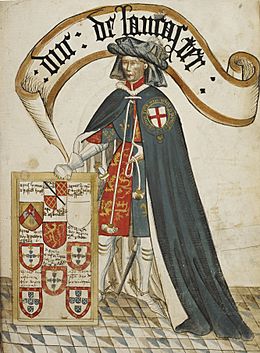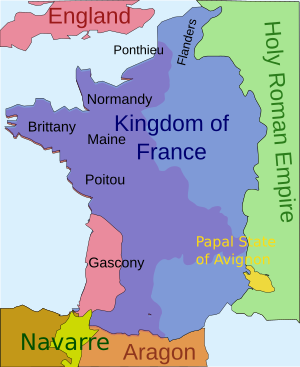Battle of Auberoche facts for kids
Quick facts for kids Battle of Auberoche |
|||||||
|---|---|---|---|---|---|---|---|
| Part of the Gascon campaign of 1345 during the Hundred Years' War | |||||||
|
|||||||
| Belligerents | |||||||
| Kingdom of England | Kingdom of France | ||||||
| Commanders and leaders | |||||||
| Henry, Earl of Lancaster | Louis of Poitiers † | ||||||
| Strength | |||||||
| 1,200 | 7,000 | ||||||
| Casualties and losses | |||||||
| Light | Heavy | ||||||
The Battle of Auberoche was a major fight on October 21, 1345. It happened during the Hundred Years' War, a long conflict between England and France. This battle saw a smaller English and Gascon army of 1,200 soldiers, led by Henry, Earl of Derby, defeat a much larger French army of 7,000. The French army was commanded by Louis of Poitiers.
The battle took place near the village of Auberoche in what is now France. At the time, this area, called Gascony, was controlled by the English king. The "English" army actually had many Gascon soldiers from the local area. This victory was a big turning point. It showed that the English could win against larger French forces. It also helped Henry of Lancaster become known as a very skilled warrior.
Contents
Why the Battle Happened
Since 1066, English kings had owned lands in France. This meant they were technically vassals, or loyal subjects, to the French king for those lands. Over time, England's land in France shrunk. By 1337, only Gascony in the southwest and Ponthieu in the north were left.
Gascony was very important to England. It produced a huge amount of wine, which was shipped to England. This trade brought a lot of money to the English king. The people of Gascony preferred being ruled by the distant English king. They felt he interfered less than the French king would.
The French kings, however, wanted to take back all these lands. They saw England's control as a threat. In 1337, the French king, Philip VI of France, decided to take back Gascony. This decision started the Hundred Years' War, which lasted for 116 years.
For years, Gascony was often left to defend itself. The French frequently attacked. In 1339, they even tried to capture Bordeaux, the capital of Gascony. The fighting was often about controlling castles and fortified towns. These places were important for trade and moving armies.
By 1345, English territory in Gascony was mostly a narrow strip along the coast. The French had strong castles inland. Some of these castles, like Libourne, Blaye, and Langon, were very close to Bordeaux. They could block important supply routes and threaten the city.
Planning the Attack
In early 1345, the English King Edward III of England planned a big attack on France from three different directions. One force would go to Brittany, another to Gascony, and the main army would go to northern France.
Henry, Earl of Derby, was chosen to lead the Gascony attack. He was given a lot of freedom to decide how to fight. His main instruction was to "do the best you can" if there was war.
The French knew about these plans. They expected the main English attack in northern France. So, they put most of their resources there. They told their lords in the southwest to defend themselves. But because a truce was in place, many local lords didn't spend money on defenses.
Before the Battle
Derby's army sailed from England in late May 1345. Bad weather delayed them, and they finally arrived in Gascony in late July. But the local Gascon lords, expecting Derby earlier, had already started fighting. They captured two castles, Montravel and Monbreton, which broke the truce.
An English advance force, led by Ralph, Earl of Stafford, began besieging French strongholds like Blaye and Langon. These sieges were easy to supply by ship. Meanwhile, small groups of Gascons raided French areas, tying up French soldiers.
King Edward III's main army, meant for northern France, also faced problems. Storms scattered their ships, and they couldn't launch their attack before winter. This meant the French could send more soldiers to Brittany and Gascony. Peter, Duke of Bourbon was put in charge of the French forces in Gascony.
Victory at Bergerac
On August 9, 1345, Derby arrived in Bordeaux with his soldiers. After two weeks of getting ready, he marched to Langon and joined Stafford's forces. Stafford had been careful, but Derby wanted to attack the main French army directly.
The French had gathered their forces at Bergerac, an important town with a bridge over the Dordogne River. Derby decided to attack them there. Capturing Bergerac would give the English a strong base. It would also help an allied castle nearby and cut off French communications.
Derby moved quickly and surprised the French army. He attacked them in a running battle, known as the Battle of Bergerac. The French suffered heavy losses, with many killed or captured. Their commander was also taken prisoner. The remaining French soldiers retreated north to Périgueux.
Within days, Bergerac fell to the Anglo-Gascon army and was looted. Derby left a large group of soldiers there and moved north. He then pushed west towards Périgueux, capturing several strongholds along the way.
Périgueux had old, weak defenses, but a large French force was defending it. Derby blocked the city, capturing points that controlled the main roads. John, Duke of Normandy, the French king's son, gathered a huge army of over 20,000 men. In early October, this large French force relieved Périgueux and pushed Derby's army back towards Bordeaux. The French then began to besiege English-held strongholds.
The Siege of Auberoche
The main French army, about 7,000 strong, led by Louis of Poitiers, began to besiege the castle of Auberoche. This castle was about 9 miles (14 km) east of Périgueux. Auberoche was built on a rocky hill, controlling the Auvézère River and the valley road. The small English and Gascon soldiers inside were led by Frank van Hallen.
The French camp was split into two parts. Most soldiers camped near the river, between the castle and the village. A smaller group was positioned to stop any rescue attempts from the north. A messenger from the castle managed to get through the French lines and reached Derby. Derby was already heading back to the area with a smaller force of 1,200 English and Gascon soldiers.
The Battle of Auberoche

Derby knew his army was much smaller than the French force. He waited near Périgueux for a few days, hoping more English soldiers would arrive. But he learned that another huge French army, led by the Duke of Normandy, was only 25 miles (40 km) away.
On the evening of October 20, Derby decided he couldn't wait any longer. He made a night march, crossing the river twice. By morning, his army was hidden on a wooded hill about a mile (1.6 km) from the main French camp. Derby personally scouted the French positions. He decided to attack immediately, hoping to surprise the French before they could get ready.
Derby planned a three-part attack. The attack began while the French were eating their evening meal. They were completely surprised. English longbowmen shot arrows from the trees into the French camp. The French soldiers were packed together and not wearing their armor. They suffered heavy losses from the arrows. One writer at the time estimated about 1,000 French soldiers were killed just by the archers.
While the French were confused by the arrows, Derby led a cavalry charge with his 400 men-at-arms from the south. They had to cross about 200 to 300 yards (180 to 270 meters) of flat ground. French soldiers struggled to put on their armor, but their commanders tried to rally their still larger forces.
At the same time, a small group of Anglo-Gascon foot soldiers had quietly moved through the woods. They attacked the French from behind, from the northwest. The fighting around the camp continued for some time.
Inside the castle, Frank van Hallen realized that the French soldiers guarding him were distracted by the battle. He led his mounted men out of the castle and attacked the French from their rear. This third surprise attack caused the French defense to completely break apart. They fled, with the English cavalry chasing them. The French soldiers in the smaller camp to the north also ran away without fighting.
The number of French casualties is not exactly known, but it was very high. Many French nobles were captured. Lesser soldiers were often killed, as was common in those times. The French commander, Louis of Poitiers, died from his wounds. Many important French leaders were captured, including two counts, seven viscounts, three barons, and many knights.
What Happened Next
The French left behind a huge amount of supplies and valuable items. The English soldiers also made a lot of money from the ransoms paid for the captured French nobles. Derby himself was said to have made a fortune from the prisoners.
The Duke of Normandy, hearing about the terrible defeat, lost his courage. Even though his army was much larger, he retreated to Angoulême and sent his soldiers home. The French also stopped all their other sieges of English-held castles.
Derby was left almost completely unopposed for six months. During this time, he captured more towns, like Montségur, La Réole, and Aiguillon. This greatly increased English territory and power in southwest France.
This victory boosted the morale of the local people and helped England gain more taxes and new soldiers. Many local lords decided to support the English king. This four-month campaign was a huge success for England in the Hundred Years' War. It gave the English control in the region for over thirty years.
Historians today praise Derby's leadership in this campaign. They call his tactics "brilliant" and "genius." A writer from that time described him as "one of the best warriors in the world." Derby continued to lead successful campaigns in the years that followed.
|



